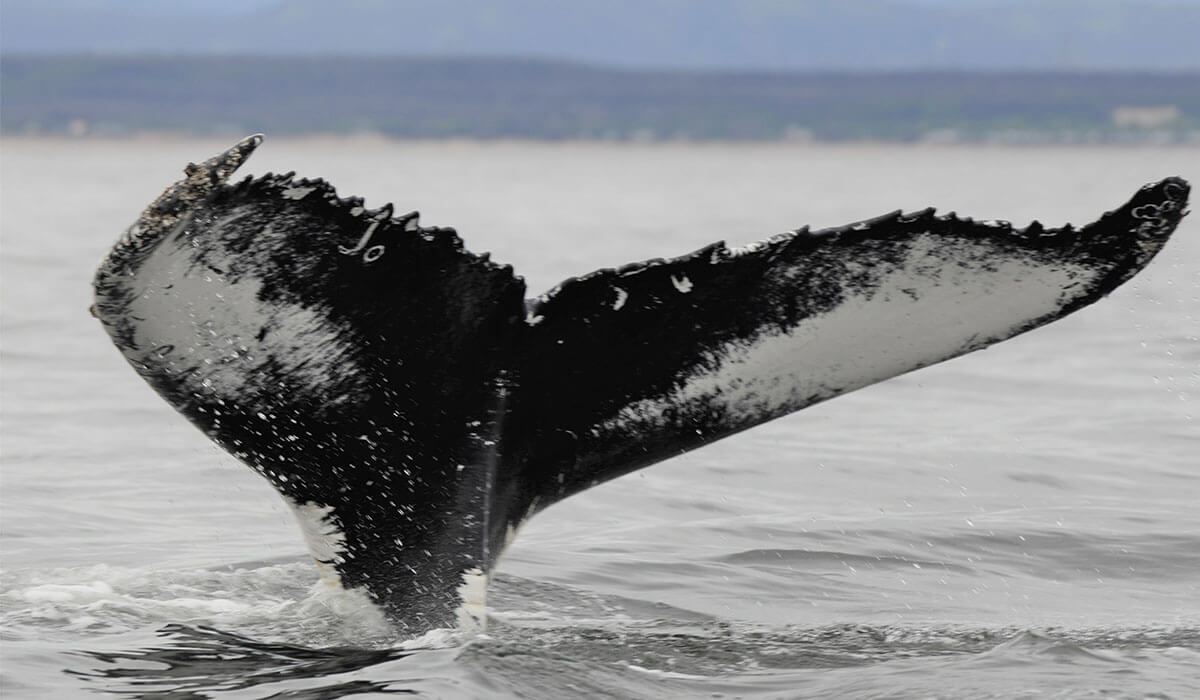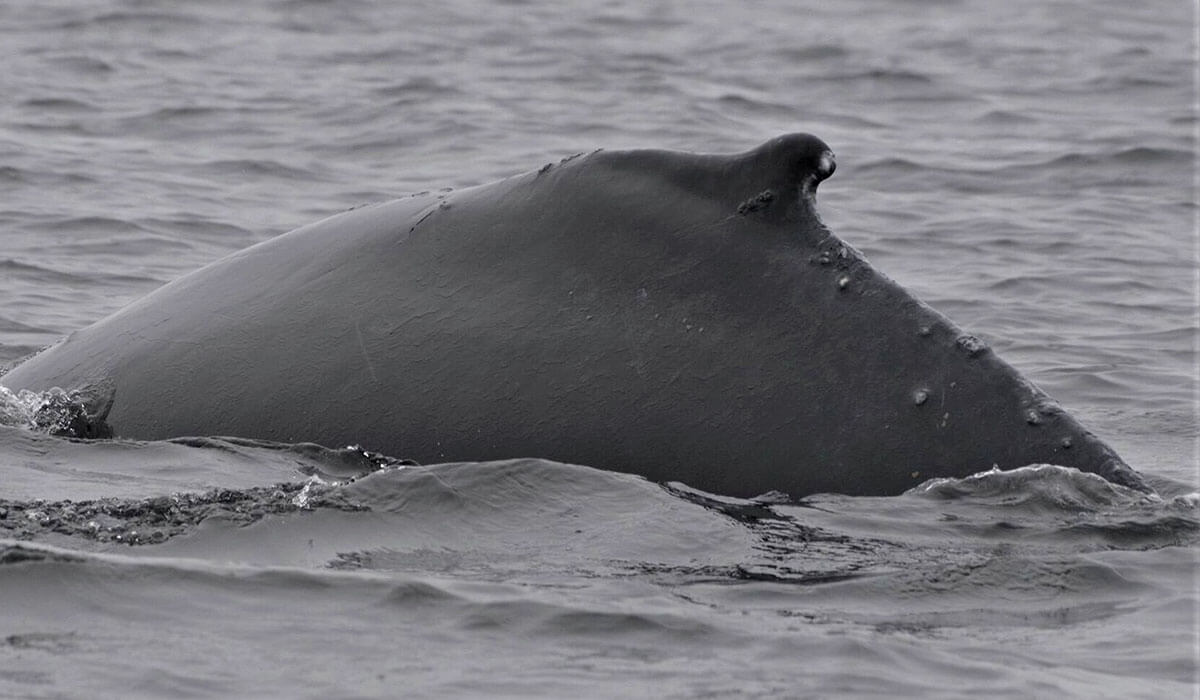By Anik Boileau, Veterinary Science Researcher and Director of CERSI
With the arrival of fall in the Sept-Îles region, it’s not uncommon to find large rorquals west of Baie Sainte-Marguerite, near Port-Cartier. On September 27, we head out at 8 a.m. from the docks of Port-Cartier with our colleague Jacques Gélineau. The sea is not perfectly smooth but still relatively calm, with southwest winds of less than 5 knots.
With such a vast expanse of water before us, we need to narrow down our search area. Jacques was out on the water the day before and was able to photo-ID two blue whales in the western sector. This is the first tip we use to help us plot our itinerary. Suddenly, after just 4 minutes on the water, Jacques’s phone rings: it’s Larry Mercier and Richard Blais, two hardcore observers who set sail even earlier than us! “We have 1 blue, 6 fins and two humpbacks southwest of Île du Corossol.” “Perfect,” yells Jacques, “we’re on our way!” The immensity of the open sea suddenly becomes a well-defined route not only on the dashboard, but also in terms of where we focus our attention.
After 15 minutes, we can see large spouts and a small boat. It’s Larry and Richard, without a doubt. We approach slowly so as not to stress the animals and turn off the boat’s engine. The wait always seems to be interminable, but during this time, we prepare our data collection sheets and equipment: chronometers, ethogram, cameras with suitable lenses, drones ready for take-off!
After 12 minutes, a fin whale finally blows in ! We slowly approach to position ourselves parallel to the animal’s right side to be able to photo-ID its chevron. Wow, a second individual is right behind this one! It’s a pair! Like blue whales, fin whales are often seen paired up in the fall. Is this behaviour associated with breeding in fin whales as well? As soon as the animals dive, we see two more blows to the west.
Jacques is busy filling out the data sheets. For the past fifteen years or so, he has been particularly interested in the correlation between the geolocation of different species and underwater topography. Once the note-taking is done, we move farther west to try and spot the two new spouts.
Seven minutes later, surprise!… Our two mystery breaths are those of a female humpback: Hockey (as per the Mingan Island Cetacean Study (MICS) catalogue) together with her calf! This female has a very distinctive mark on the left lobe of her caudal fin where a graffiti-like “Jo” seems to be inscribed! “Why is she called Hockey then?” wonders Jacques. I think the J resembles a hockey stick and the O looks like a puck!
On June 19, we had observed Hockey and her calf south of Île du Corossol. The calf had some pustules and skin lesions on its right and left flanks, behind the dorsal fin. In our monitoring of the well-being and health of the humpbacks and fin whales of the St. Lawrence, this is precisely the kind of situation we want to document! We stay far enough away to avoid stressing the animals, but thanks to the powerful lenses of our cameras, we’re able to take important photos, which, unfortunately, show a deterioration in the skin condition of the calf we nicknamed “Picotine”.
On June 19, we had observed Hockey and her calf south of Île du Corossol. The calf had some pustules and skin lesions on its right and left flanks, behind the dorsal fin. In our monitoring of the well-being and health of the humpbacks and fin whales of the St. Lawrence, this is precisely the kind of situation we want to document! We stay far enough away to avoid stressing the animals, but thanks to the powerful lenses of our cameras, we’re able to take important photos, which, unfortunately, show a deterioration in the skin condition of the calf we nicknamed “Picotine”.
Back in our office, the research continues to figure out what disease our calf might have. A review of literature points us in different directions: lobomycosis, poxvirus, calicivirus?
Around the globe, skin diseases in cetaceans have been increasingly prevalent in the last 20 years. This phenomenon seems to be attributable to environmental degradation and a close link has been established with the salinity in the marine ecosystem. Etiology (word of Greek origin which means the search for causes) suggests three possible origins: viral, bacterial or mycological. If we analyze the skin lesions of Picotine, we begin with a process of elimination, otherwise known as differential diagnosis. The lesions appear to be ulcerous, so we can eliminate the poxvirus, as the lesions are in the form of round spots referred to as “tattoo skin disease”. We proceed in this manner until we have a plausible idea of the origin of the condition. Of course, we cannot make an official diagnosis, as this would require a skin sample and a veterinary pathology analysis conducted at the Faculty of Veterinary Medicine in Saint-Hyacinthe. On the other hand, as other researchers do, we can categorize the condition as an unspecified nodular skin disease. Perhaps we will have the chance to have a skin sample analyzed to obtain a more accurate diagnosis!
We haven’t seen Picotine or its mother Hockey since September 27. Have they already departed for their long journey to warmer waters? One thing is for sure, we hope they will come back to us next summer in better health!
To Dive Deeper
- Dierauf, L. A., Gulland, F. M. D., & Whitman, K. L. (Karyl L. (2018). CRC handbook of marine mammal medicine. (CRC Press, Ed.) (3d ed.). Taylor & Francis.







